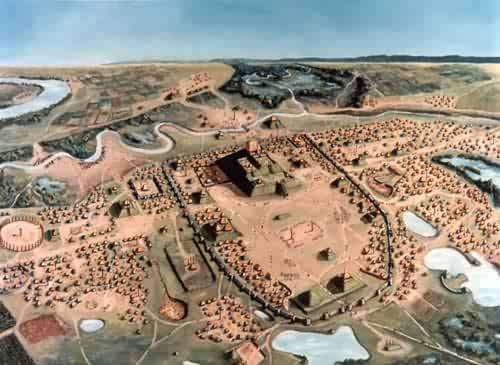|
Digital
History>eXplorations>The
World Before 1492
Exploration
4 : Cahokia

These
are all images of different ancient ruins (or graphic replicas)
of ancient civilizations in the Americas. What appears similar
or different about these?
Essential
Questions
Mississippian
Period and the Mounds at Cahokia
1.
The era between A.D. 1000 and 1600 during is known as the
Mississippian period. Who were the “Mississippian”
people and what was their way of life and economy based
on?
2.
What do the mounds at Cahokia suggest about their builders’
religious and cultural beliefs?
This
is an artist's rendition of what the Cahokia site might have
looked like.

Many
Americans visit Stonehenge in England. They are unaware that
their own country contains similar feats of ancient engineering.
One mound, located across the Mississippi River from St. Louis,
is larger than the Great Pyramid in Egypt. Its base covered
14 acres and it rose in four terraces to 100 feet.
Nearly
a thousand years ago, when many European cities were little
more than villages, the people living at Cahokia, near present
day St. Louis, built a wooden barricade surrounding their
most important buildings. Almost two miles long and enclosing
more than 120 acres, the fence required felling 20,000 trees.
Cahokia,
the largest settlement north of central Mexico, flourished
for three centuries before it was abandoned. Estimates of
its peak population run from 10,000 to 20,000. Cahokia’s
merchants traded across much of North America, from the Gulf
Coast northward to the Great Lakes, eastward to the Atlantic
coast and westward to Oklahoma. Cahokia spread the Mississippian
culture across much of North America.
At
Cahokia’s core, within a log stockade ten to 12 feet
tall, was the 200-acre Sacred Precinct where the ruling elite
lived and were buried. On top of a massive earthen mound stood
a pole-framed temple more than 100 feet long, where Cahokia's
rulers performed the political and religious rituals. Cahokia’s
streets and 120 mounds were apparently laid out according
to their builders’ spiritual principles and view of
the cosmos. To explore Cahokia is to re-experience the wonder
of a vanished civilization and way of life.
Read
more about Cahokia:
Cahokia:
Cosmic Landscape Architecture
This excerpt is mirrored on Digital History through permission
of the University of Chicago Press.
Resources:
(Links will open in a new window; close that window
to return to this page)
Cahokia
Mounds
Aztec
Pyramids
Anasazi
|
